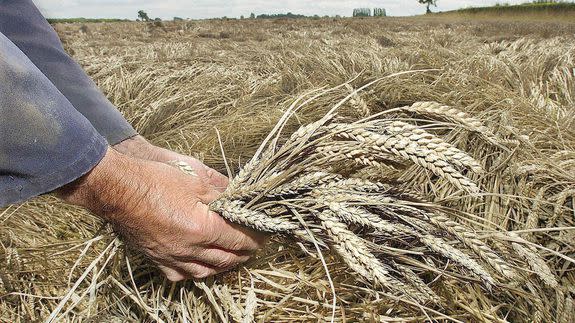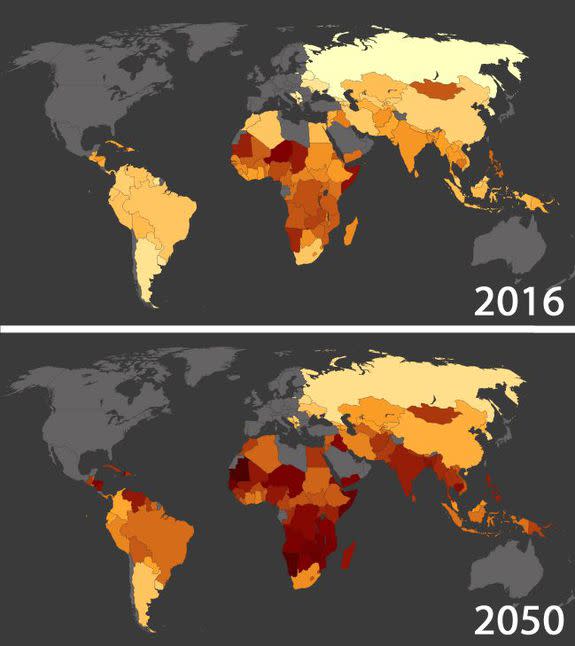6 ways climate change is threatening food security — and what we can do about it

Climate change could have a devastating impact on food security around the world.
Eliminating hunger and curbing the effects of climate change are both U.N. Sustainable Development Goals (SDGs), which world leaders are committed to achieving by 2030. And, like many SDGs, these two pressing issues are interconnected.
SEE ALSO: This company wants you to text with 'ugly' fruit emoji to fight food waste
Research shows that a combination of more frequent and intense climate disasters, decreases in crop yields and production, and a lack of natural resources will worsen food insecurity — and threaten the livelihoods of millions of people.
For this year's World Food Day on Oct. 16, advocates are turning their attention to the climate to help address this issue.
To show why it's essential to include global warming in conversations about food insecurity, here are six facts about the intersection of hunger and climate — and what experts say we need to do going forward.
1. By 2050, climate change impacts could increase the risk of food insecurity by up to 20 percent.

Image: World Food Programme
According to the World Food Programme, without dedicated efforts to curb the impacts of climate change on the environment, we risk increasing hunger and the breakdown of reliable food systems for communities around the globe.
Regions already feeling the biggest impacts of hunger, including Africa, South and Central America, and the southernmost parts of Asia, are projected to be hit the hardest. Poor women and children — two groups most affected by hunger — are especially vulnerable. Poor communities in areas prone to climate disasters are also at risk, since food and nutrition crises can occur in the aftermath.
What we can do
Experts are optimistic that drastically decreasing greenhouse gas emissions and helping global communities adapt to climate change could help mitigate the threat. Completely addressing food insecurity by 2050, however, is unlikely even in the best scenario, given the impacts of global warming on the planet already.
You can explore what climate action can do to the world's food supply by using this interactive map from the World Food Programme.
2. To adequately feed the global population in 2050, crop production would have to double.
Some tips to combat the effects of climate change on Food and Agriculture #ClimateIsChanging #FoodAndAgricultureMustToo #WorldFoodDay2016 pic.twitter.com/PaKhcRj0CH
— CARIRI (@cariri_tt) October 4, 2016
By the year 2050, the world's population is expected to grow from about 7 billion to an estimated 9.1 billion. Within that population, 8 billion people are expected to live in developing countries, where food security is already a rarity.
Production of rice and wheat alone — two of the most farmed crops worldwide — could decrease 8 and 32 percent, respectively. With current global trends in diet and production taken into account, food production will have to increase a staggering 60 percent to accommodate both population growth and decreased crop yields.
What we can do
To accomplish the frequently cited goal of doubling crop production, food producers worldwide would have to increase the amount of sustainable crops without having more of an adverse impact on the environment.
Research suggests that farmers should improve their practices by producing resilient crops along with more fragile varieties of plant life, keep soil nutrient-rich and optimize irrigation. Some experts also recommend a shift in global diets to more sustainable crop options.
3. Catches of the world's most relied-upon fish are expected to decrease by up to 60 percent by 2050.
Projected change in global fisheries revenues under climate change @nature https://t.co/2Qzc8z0kdL pic.twitter.com/CQv8mo77OS
— FAO statistics (@FAOstatistics) October 11, 2016
By 2050, fish yields in the Tropics and Antarctica are expected to fall by 40 to 60 percent due to overfishing and species migration to more temperate locations. This threatens the income of fishers in the region, as well as the underwater ecosystem. The global fishing industry could lose an estimated $17 billion to $41 billion due to climate change by 2050.
But fish aren't only vital to the global economy — they're also a major source of nutrition around the world. With rising ocean temperatures, ocean acidification and overfishing of particular species, there is a massive risk of diminishing the fish populations we rely on so heavily for food consumption.
What we can do
The U.N. Food and Agriculture Organization says creating sustainable fisheries are crucial, and recommends that the global population switch to consuming less-fished species to help replenish at-risk species. Experts also recommend supporting a stronger underwater ecosystem by restoring breeding sites and habitats.
4. Livestock contributes almost 80 percent of agricultural methane emissions, and about 66 percent of greenhouse gas emissions.
What is enteric methane & why reducing it improves livelihoods & food security: https://t.co/G0mGTt46rV pic.twitter.com/sa204AMML5
— FAO statistics (@FAOstatistics) August 22, 2016
Livestock are an essential source of income and food for many communities around the world. But their growing populations can threaten the environment if they aren't raised sustainably.
Of the estimated 730 million poor people living in rural areas across the globe, about 430 million — more than half — are livestock farmers who predominantly rear ruminant animals like cattle. During the digestion process, cows produce methane that is then expelled into the atmosphere. While one cow doesn't necessarily make much of a difference, the global population of 1.5 billion cattle does. After all, methane traps 84 times more heat than carbon dioxide over the first 20 years after it's released into the air.
What we can do
Cutting cattle populations would help curb the problem, but experts say that isn't practical — especially in terms of global food insecurity. Instead, it's recommended that farmers cut down on other sources of methane, like fertilizers, while also improving their cows' diets to help curb methane emissions.
Experts also suggest that poor livestock farmers include crops in their production to increase financial stability, rather than looking to raise more animals than their land can accommodate.
5. Food loss or waste generates about 8 percent of annual greenhouse emissions.
Food Waste is a #Global problem of breathtaking scope by @ashakman #Infographic https://t.co/fcjdBVJQfN pic.twitter.com/3Q2yfUw1uE
— Agri24Seven (@agri247global) July 1, 2016
Currently, one-third of all food produced in the world is lost or wasted during production or consumption. This not only negatively impacts the global food supply, but also the environment, accounting for 8 percent of annual greenhouse gas emissions.
Food waste during preparation and consumption is a concerning issue, but food loss during production is often overlooked, even though it's where most food waste originates. In the U.S. alone, roughly 1 out of every 5 edible fruits and vegetables are thrown out every year before getting the opportunity to hit store shelves.
What we can do
Experts recommend improving waste reporting by farmers and fishers, while also encouraging consumers to keep tabs on their own food waste. You can find practical tips on how to reduce your own food waste here.
6. 78 percent of the world's food-insecure people rely on agriculture for their livelihoods.
Prioritizing #agriculture in #climatechange adaptation so farmers can continue to feed the world https://t.co/7SbSBUwTFw #zerohunger pic.twitter.com/O9tdnydxEG
— FAOKnowledge (@FAOKnowledge) October 9, 2016
An adequate food supply isn't just crucial for sustained nutrition — it's also essential to the economic well-being of food producers. People who produce food — like farmers and fishers — are often hit hardest by climate change, which directly affects their personal food supply and sources of income.
With about 78 percent of the world's poor relying on farming to support their families, it's important to develop sustainable ways of farming that support both the environment and those who rely on crops for economic stability.
What we can do
Experts say adaptation and mitigation in the agriculture sector are necessary, and they also encourage food producers to curb their personal impacts.
But that can be difficult, especially in developing nations without the resources to improve their farming. As a result, organizations like the United Nations and Sustainable Harvest are working to empower farmers around the world with the tools needed to create more sustainable farming practices.
